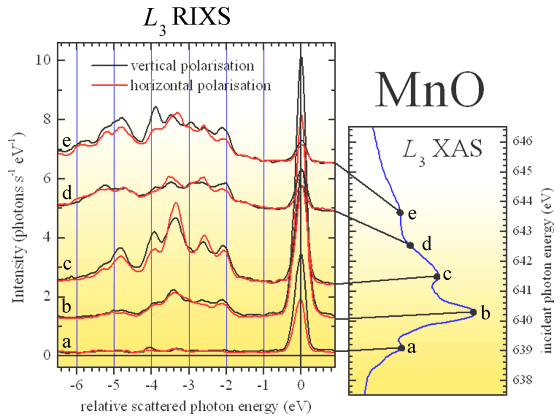- Home
- News
- Spotlight on Science
- When Resonant Inelastic...
When Resonant Inelastic X-ray Scattering is Soft: improved resolution of the AXES spectrometer at ID08
26-10-2004
Share
Resonant Inelastic X-ray Scattering (RIXS) can be effectively used to study the low energy electronic and magnetic excitations in solids. Working at the L2,3 absorption edges is ideal in 3d transition metals compounds, because the resonant excitation and de-excitation allow us to measure the energy of excited states unreachable by direct electric dipole transitions. Those excited states (among them the so-called dd excitations) extend from a few eV down to the tens of millielectronvolt energy scale. As the 2p state binding energies of 3d transition metals are between 400 eV and 1000 eV, they fall in the energetic range of the soft X-rays of beamline ID08. To record good RIXS spectra a high resolving power is needed both in the monochromator (before the sample) and in the spectrometer (after the sample). This is challenging as RIXS is intrinsically a very low count rate experiment, requiring a high flux in a small region of the sample.
At ID08 RIXS has been measured for more than 10 years thanks to the AXES spectrometer and to PoLIFEMo, a dedicated monochromator (both are property of INFM-CNR, designed and developed at the Politecnico di Milano). After the recent upgrade of the whole instrumentation we can now reach a combined resolving power of 2000 (at the Mn L3 edge, 640 eV), which allows us to observe structures not resolved previously (Figure 1). The remarkable performance of AXES has already been exploited to study the dd excitations in the cuprates (Figure 2) [1], where the spectra show a sensitivity to the Cu local environment in the various compounds (NB: the resolving power has further increased since those data were measured).
 |
|
Fig. 1: RIXS spectra across the L3 edge of Mn in MnO. The scattering angle is 70°. Red (black) lines give the spectra measured with the incident photons linear polarisation parallel (perpendicular) to the scattering plane. |
|
|
|
Fig. 2: RIXS spectra at the Cu L3 absorption peak of cuprates. The dd excitations give a peak around -2 eV, the charge transfer excitations give a broad feature down to -7 eV [1]. |
Reference
[1] G. Ghiringhelli, N.B. Brookes, E. Annese, H. Berger, C. Dallera, M. Grioni, L. Perfetti, A. Tagliaferri, and L. Braicovich, Physical Review Letters 92, 117406 (2004).
Authors
L. Braicovich (a), N.B. Brookes (b), C. Dallera(a), G. Ghiringhelli (a), A. Tagliaferri(a)
(a) INFM-CNR and Dipartimento di Fisica, Politecnico di Milano (Italy)
(b) ESRF




